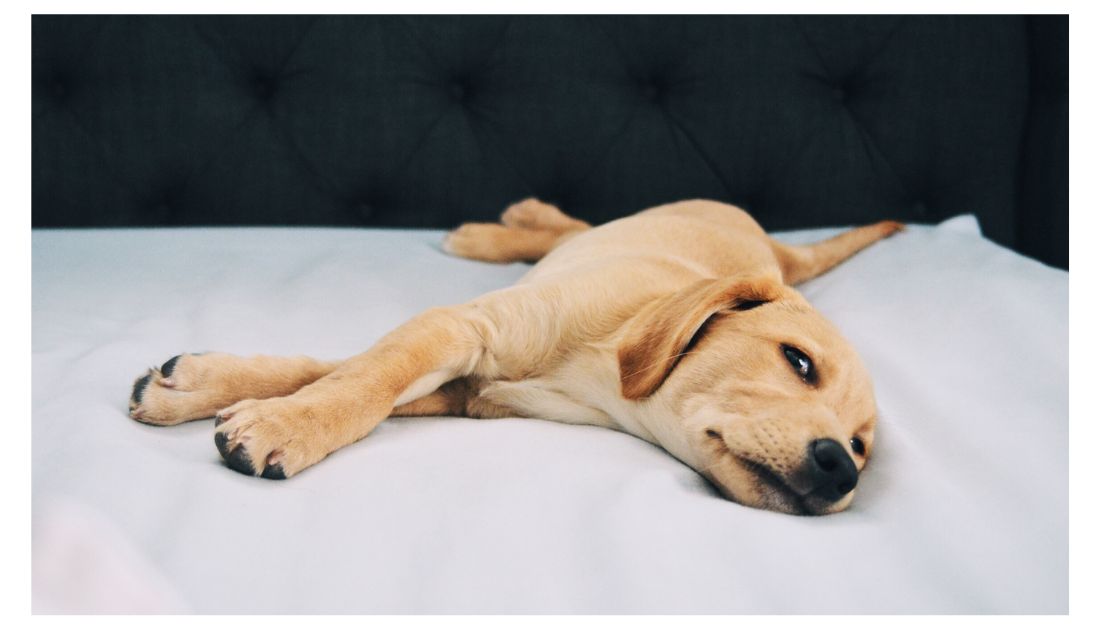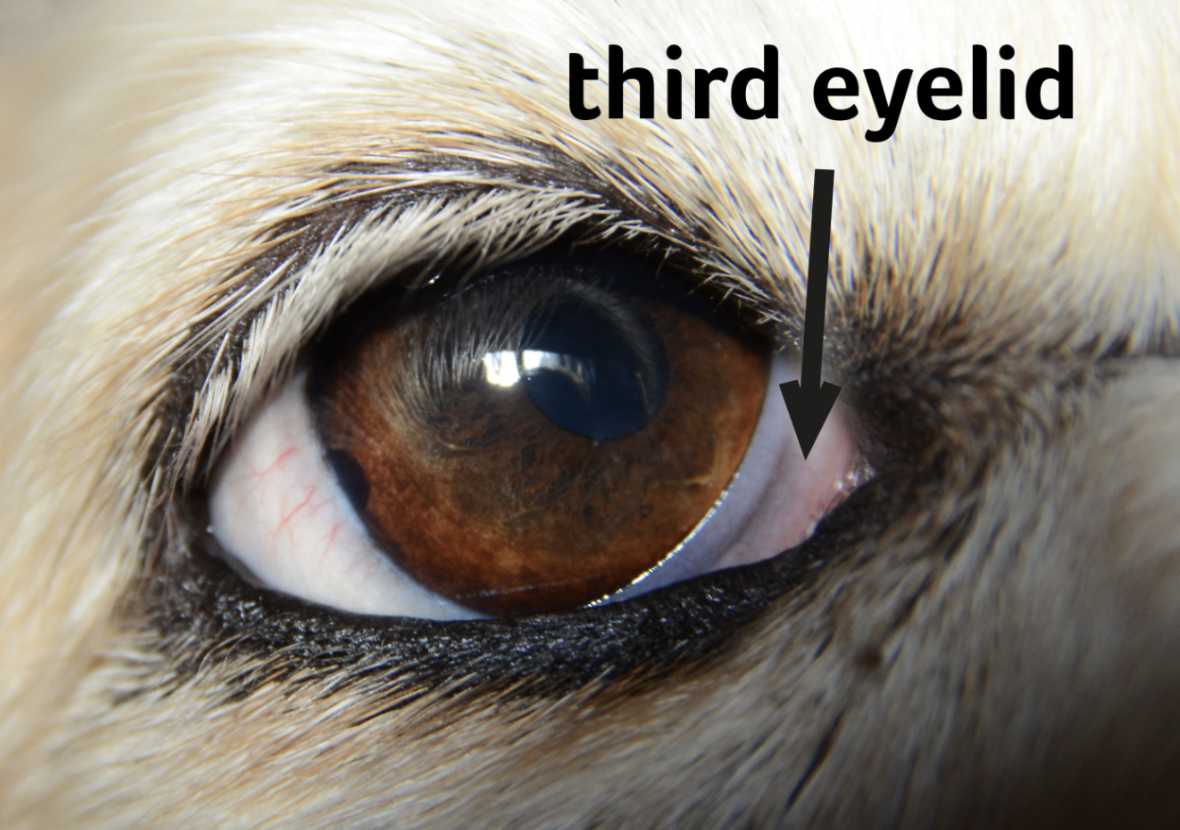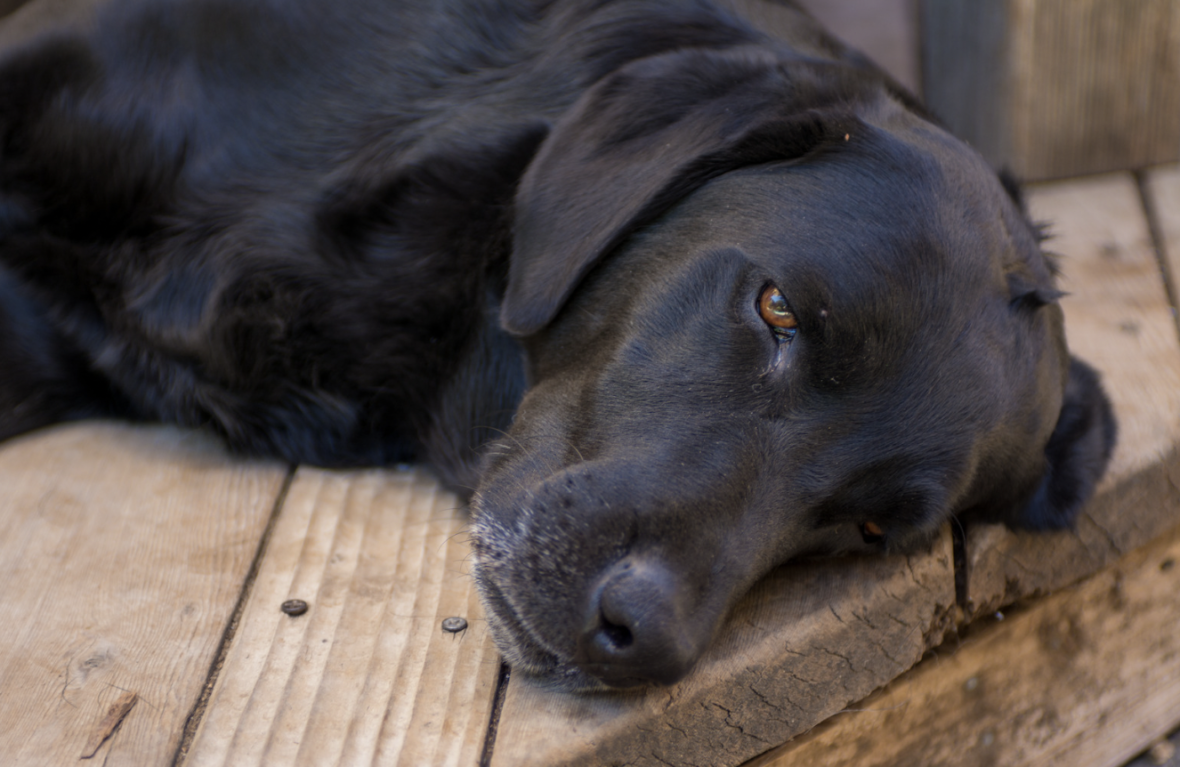Why Do Dogs Sleep with Their Eyes Open?
Have you ever thought your dog was sound asleep, only to look over and see that their eyes are open? The first few times you see this, it can be a little disconcerting. After all, you saw your dog close their eyes—shouldn’t they be fast asleep?
As strange as it may seem, most dogs sleep with their eyes partially open for at least part of their sleep cycle. Yep, you read that right: it’s normal for dogs to sleep with their eyes open, at least some of the time.

Here, we’re discussing what normal eye movements look like when your dog is asleep, explaining why dogs sometimes sleep with their eyes open, and covering what you should look for if you’re worried about your dog’s sleep quality.
Mystery Solved: Why Dogs Sleep with Their Eyes Open
Almost every dog spends at least part of their time sleeping with their eyes fully or partially open. One reason your dog’s eyes might be open while asleep is that they have entered a REM (rapid eye movement) cycle and are dreaming. Open eyes, twitching eyelids, eye movements, and twitching limbs are all common when your dog is deep asleep, and nothing to worry about.
Another reason your dog’s eyes might open while they sleep is simple anatomy. Humans have two eyelids, an upper and a lower eyelid. Dogs have three, the upper, lower, and inner eyelids. The inner eyelid is tucked away in the corner of the eye, so you might not always notice when it closes. If your dog’s upper and/or lower eyelids are open, it’s very likely that their third eyelids are still closed and protecting the eye.

There are several theories on why dogs sometimes sleep with their eyes open. Some believe this could be an evolutionary trait passed down from their wolf ancestors who needed to be on high alert for danger. Others think it could have given working dogs an advantage, allowing them to detect predators even while asleep.
It’s also worth noting that dogs will often sleep with their eyes partially open during the day. This may not be the same type of open-eye sleep they do at night. Instead, during the day, your dog could be in a state of half-alertness, and simply be resting their eyes while still keeping part of their focus on their surroundings.
So, to sum things up: it’s perfectly normal for your dog to sleep with their eyes open! If your dog’s eyes are never fully closed, and you’re concerned there may be an issue, reach out to your vet to set up an appointment.
Possible Medical Conditions Related to Sleeping with Eyes Open

Most of the time, your dog sleeping with its eyes open is no big deal. However, there can on occasion be a related or underlying condition affecting their ability to fully close their eyes. In some very rare cases, fluttering eyelids, eye movement, and twitching can be a sign of a more serious illness like epilepsy or a seizure condition.
You know your dog best. If you can tell they’re in discomfort or distress, talk to your vet. Most dogs twitch and move their eyes while dreaming, so don’t panic if you notice this behavior without other signs of health problems.
Some other medical conditions that may affect your dog’s sleep or eyes include:
- Narcolepsy
- Eye infections
- Glaucoma
- Cherry eye
Explaining the Canine Sleep Cycle
Dogs sleep 12 or more hours a day including a full night of sleep and naps during the day. Older dogs or dogs with lower energy levels can easily sleep more than 12 hours a day while dogs bred for alertness (livestock guardian dogs, for example) may sleep less.
While humans have sleep cycles of around 90 minutes, the canine sleep cycle is only about 20. Once your dog falls asleep they experience around 12-14 minutes of light sleep followed by 6-8 minute REM cycles according to this study. This same study showed that dogs do best when their sleeping pattern can begin around 9 PM and finish around 6 AM with additional rest in the afternoon.
What Dog Breeds Sleep with Their Eyes Open Most Often?

While all dog breeds can (and do) sleep with their eyes open occasionally, there may be some breeds that are more prone to this than others. Brachycephalic breeds (like the Pug and French Bulldog) are more likely to sleep with their eyes open due to their unique facial structure. Similarly, dogs with droopy faces and skin (like Basset Hounds) may be more likely to sleep with their eyes open because of gravity.
Some dog breeds that are prone to congenital eye problems may also sleep with their eyes open more often than other breeds. Bloodhounds, Spaniels, and Bulldogs are just a few examples.
Dog Sleeping with Eyes Open FAQ
Do you have more questions about your dog sleeping with its eyes open? Here’s what others wondered about this subject.
Do blind dogs sleep with their eyes open?
Sometimes! Blind dogs usually close their eyes when they go to sleep out of instinct, but their eyes can open just like any other dog while they’re in deep sleep.
Can dogs sleep with their eyes open on purpose?
Sort of. While your dog probably isn’t thinking that they’re going to sleep with their eyes open, this behavior may be useful for working dog breeds like livestock guardian dogs.
Do dogs have three eyelids?
Yes! Dogs have a third, protective inner eyelid tucked into the corner of their eyes. Called the nictitating membrane, this third eyelid helps to protect your dog’s eyes from debris and is often out—even if you can’t see it—to protect their eyes when they sleep.
Why does my dog sleep with their eyes open?
Dogs may sleep with their eyes open due to a condition called “sleeping with eyes open” or nocturnal lagophthalmos.
How does sleeping with eyes open affect a dog’s sleep?
Sleeping with eyes open can potentially affect a dog’s sleep quality, as it may interfere with the normal stages of sleep and the body’s ability to achieve restorative rest.
Is the heart rate of a dog affected by sleeping with eyes open?
While heart rate can be influenced by several factors, sleeping with eyes open itself may not directly impact a dog’s heart rate during sleep.
Can sleeping with eyes open be related to sleep disorders in dogs?
Yes, sleeping with eyes open can be associated with certain sleep disorders in dogs, such as REM sleep behavior disorder, where the dog’s eyes move and body temperature regulation may be affected.
Is the facial nerve connected to dogs sleeping with eyes open?
The facial nerve, which controls various facial muscles, is not directly linked to dogs sleeping with eyes open, but it plays a role in eyelid movement and could indirectly contribute to the condition.
Are eyelid weights used to treat dogs that sleep with eyes open?
Eyelid weights are not commonly used to treat dogs that sleep with their eyes open. Other treatments, such as addressing underlying conditions or providing environmental modifications, may be considered.
What are the stages of sleep in dogs, and how do they relate to sleeping with eyes open?
Dogs go through different stages of sleep, including REM (rapid eye movement) sleep and non-REM sleep. Sleeping with eyes open may disrupt the normal progression through these sleep stages.
Do dogs and people sleep for the same amount of time?
Dogs and people have different sleep patterns and durations. While people typically have longer sleep cycles, dogs have shorter sleep cycles, averaging around 120 minutes, but their total sleep time can vary based on age, breed, and other factors.
How are smooth pursuit and brain waves related to dogs sleeping with their eyes open?
Smooth pursuit refers to the ability to track moving objects with our eyes. Brain waves, on the other hand, represent the electrical activity in the brain. While both are important for normal vision and sleep, their direct connection to dogs sleeping with eyes open is unclear.
Related Articles:
- Why Do Dogs Sleep with Their Bum Facing You? Unlocking This Strange Canine Behavior
- Why Your Dog Secretly Hates Your Hugs
- Why Is My Dog Peeing In Their Sleep?



